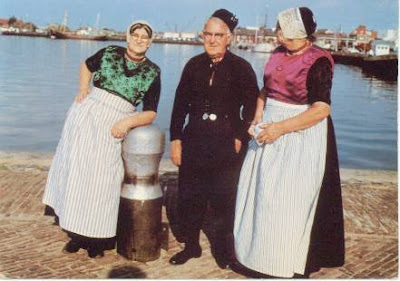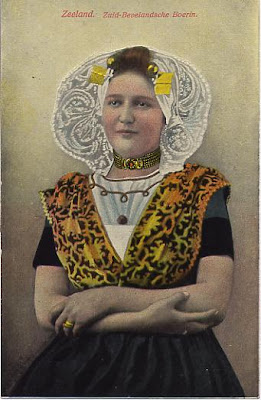 After making my bodice / kraplap for the traditional costume challenge from the European Street Team on Etsy, I thought it would be interesting to show you some pictures of bodices / kraplappen from traditional costumes in The Netherlands. Originally the kraplap was a part of the underwear, but in many parts of The Netherlands it has developed into an important decorative part of the outerwear; often very visible and showy, but also sometimes hidden under shawls only revealing a small part under the chin.
After making my bodice / kraplap for the traditional costume challenge from the European Street Team on Etsy, I thought it would be interesting to show you some pictures of bodices / kraplappen from traditional costumes in The Netherlands. Originally the kraplap was a part of the underwear, but in many parts of The Netherlands it has developed into an important decorative part of the outerwear; often very visible and showy, but also sometimes hidden under shawls only revealing a small part under the chin. 
In Marken it is worn above all other clothing parts and made from antique pieces of the most beautiful chintz (calico cloth printed with flowers and other devices in different colors).


In Urk the kraplap is more voluminous, mostly made from satin and often embroidered with flowers.


The best known kraplap is the one from Volendam, tucked under the typical short sleeve jacket, often with the most beautiful flower embroidery.


In Walcheren, it is also tucked away in the short sleeved jacket but with lots of folds and more visible because of the more open form of the jacket.


The kraplap of Bunschoten-Spakenburg is the most striking one; it's made of a handpainted cotton and fully stiffened, which makes it look like a giant collar; the red checkered vertical stripe in the middle, is the shawl folded into a strip only in such a way that the kraplap is fully visible.


In Staphorst it is often made from a black woollen muslin with flowers or from black satin handpainted with "stipwerk"; a special painting technique only used in the Staphorster costume. The flowers and stipwerk is dark coloured when the wearer is in mourning (blue and purple on black), otherwise the colours are pretty bright (red, green, yellow etc.). The checkered shawl is covering quite a part of this stunning piece. Which is very much the same situation on the Veluwe, where the kraplappen are not so very brightly patterned.




In Arnemuiden and on Zuid-Beveland the kraplappen are very similar, and also very much covered by the shawl. Often the shawl is made of the same fabric as the kraplap.




The most decorated kraplap is the one of Axel; it's ingeniously embroidered with glass beads and sequins leaving almost no space of the fabric to be seen. The scarf, which is folded and stuffed like a pair of wings, is covering the fabric, leaving the embroidered part visible as one big front jewel.


I hope you enjoyed this little tour through some of the traditional costumes in The Netherlands. All the pictures are postcards in my possession.
14 comments:
Very interesting reading! Thank you so much for sharing!
As a real dutch citizin I even didn't know all these differences! Thanks for the explanation!!
Such a wonderful travel through traditions and history again!
Wow that is so very cool, I love these traditional costumes.
Oh how lovely post! Really nice to read :)
oooh , interesting, but I still wonder what should mean the word 'kraplap', or how it is explained etymologic, do you also have information about that?
Het woord kraplap is een verbastering van het woord kroplap; een lap voor de krop, of te wel lijf / romp / lichaam.
The variety is incredible! I loved this feature, as I do all of your's!
Amazing! It's really sad that most of the traditional clothing get's lost over time ..
Ah prachtig weer! Ik wil heel graag een geborduurd lijfje op z'n marken's. Onmogelijk te vinden (en dan durven te dragen voor een redelijke prijs) Misschien moet ik er maar zelf een maken net als jij.
I love this!!! I have so enjoyed seeing all the variations of traditional costumes since coming to live in Norway and haven't seen many from your country. They are so beautiful!
I adore the one you made with buttons. Gorgeous work!
~Emily xx
It is really great how you interpret traditions into something modern with buttons! Wonderful work!
-minna
It was so interesting to read this post! Thanks for sharing :)
I have something for you in my blog :)
What a fantastic lesson into the history of kraplap and such amazing old photos to show us, thank so much.
Post a Comment